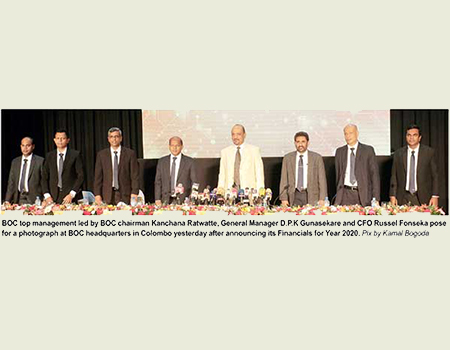
Please Share your Email if you Wish to Receive the Golden Tips & Tales Newsletter from History of Ceylon Tea Website

Bank of Ceylon’s assets base grew by 24% to LKR 2.9 trillion by end 2020 and at the point of speaking it has surpassed the 3 trillion mark, and the importance of this financial number is that it has an intrinsic value of our customers’ assets and growth potential, Russel Fonseka, Chief Financial Officer (CFO) of Bank of Ceylon said in Colombo yesterday.
“If anything happens to the national economy it reflects on BOC’s balance sheet. You may think why rupees three trillion asset base is so important. Because it does not tell a monetary value only. Anybody can give asset base numbers. But our asset base of LKR 3 trillion has an intrinsic value in the national economy. The total of this asset base may not be within the bank itself. It may be within the business peripheries of our customers; their establishments, stocks. tea factories, tea estates farms, agriculture produce, they are included in this three trillion asset base.
‘This financial number of BOC represents all sectors of the economy. That is why we are proud of the increase of our asset base and that is why I said our asset base reflects on the nation economy and not just ourselves. We will be expanding on this value in the future as well contributing to the national economy in a meaningful way,” he said.
“Although the profit in 2020 was less than in the preceding year, we have made the largest profit in the banking industry this year. Some people say that the bank industry is making high profit. That is not the truth. We have broad based assets compared to other industries. We mange and administer them. What we reap from that business is our profit. We make less than 1% profit – or about 0.87% from each of these assets. There is no other industry operating on such low profit margin. But as the quantity of assets we manage is huge, we can make profit. This is the truth although people criticise us sayong the banks are making a lot of profit,” he said.
Fonseka said so at a media briefing held by the top management of the bank to announce the Bank’s Financials for the year 2020.
BOC chairman Kanchana Ratwatte speaking at the event said that the bank ended a strenuous year with undisputed leadership position, keeping spotlight on economic revival.
“Bank of Ceylon has once again stamped its resilient leadership position by navigating an exhausting year carefully, but with great strength, continuously powering the wheels of the Sri Lankan economy despite Year 2020 was a year of many unforeseen challenges”, Ratwatte said.
BOC General Manager D.P.K. Gunasekera said that the Bank partnered with the Central Bank of Sri Lanka to maintain the dollar-rupee exchange rate with the backing of foreign remittances it received from migrant workers.
Amidst these unexpected challenges, the bank’s operating profit stood at LKR 29 billion and a reported LKR 23.6 billion as Profit before Tax (PBT) for the year 2020, moving forward with stable performance, while managing headwinds caused by low interest rates, cashflow deferments and operational restrictions. Profit After Tax (PAT) for the year ended was LKR 17.8 billion. The bank’s assets base grew by 24% to LKR 2.9 trillion, primarily backed by an increase of 28% in the loan book.
Reaching another milestone, the bank’s loan book crossed the LKR 2.0 trillion mark during the year and closed with LKR 2.1 trillion gross loans and advances to customers. Both government and private sector lending contributed to growth during the year, while working capital and personal lending showed a boost in all segments, including retail and corporate financing.
The bank’s deposit base (more than 23% of the industry) increased during the year despite low interest rates. The bank’s deposit base of LKR 2.5 trillion represents 35% of the current and saving deposit (CASA) base, which generates funds at low cost. During 2020 the bank successfully executed issuance of its first Additional Tier 1 (AT1) bond, generating LKR 15.0 billion ATI capital. The bank’s Tier I Capital and Total Capital ratio stood at 11.2% and 14.9% respectively by end 2020, which were above regulatory norms. Despite cash flow deferments on loan instalments, the bank was able to maintain better trade -off between liquid assets and liabilities. All liquid level monitoring ratios were maintained positively.
Source: https://island.lk/bocs-rs-3-trillion-asset-base-a-measure-of-its-contribution-to-economy-cfo/
Comments
(In keeping with the objectives of this website, all COMMENTS must be made in the spirit of contributing to the history of this estate, planter or person i.e. names, dates & anecdotes. Critical evaluations or adverse comments of any sort are not acceptable and will be deleted without notice – read full Comments Policy here)